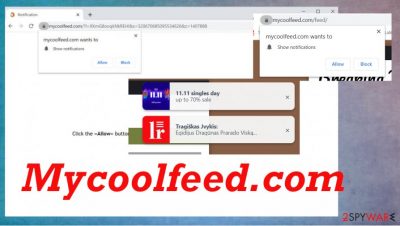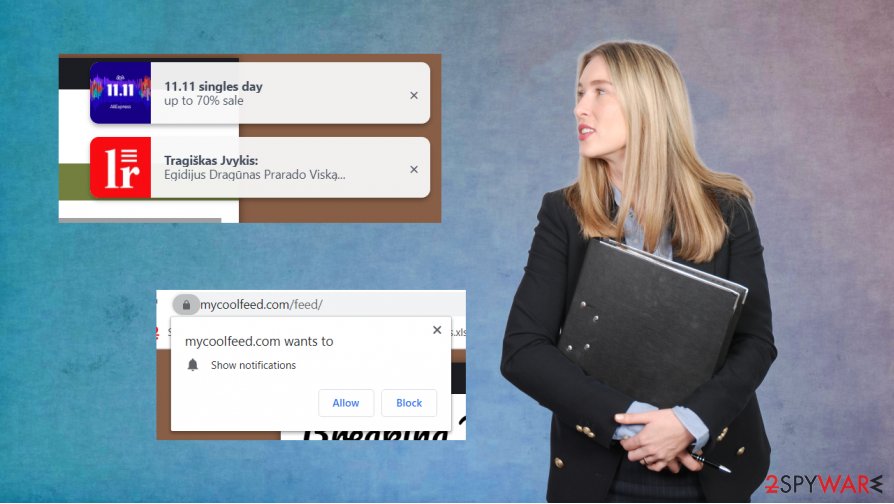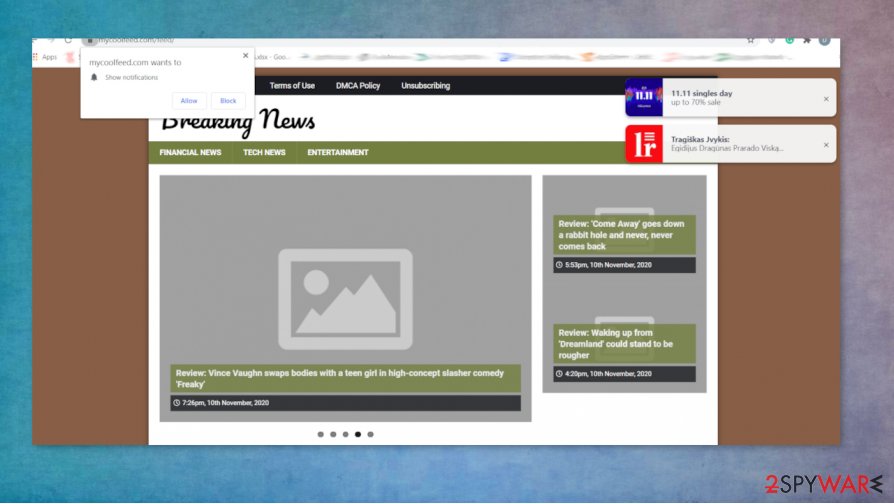Mycoolfeed.com (Free Guide) - Removal Instructions
Mycoolfeed.com Removal Guide
What is Mycoolfeed.com?
Mycoolfeed.com is the adware-type intruder that makes changes in preferences to control the traffic on the browser

Mycoolfeed.com – the program considered to be a redirect virus because it shows third-party ads and commercial content trying to trick people into allowing additional notifications. Adware[1] can be involved in various revenue-generating campaigns, so the program is not malicious, but the content delivered might be. Since the infiltration most likely happened behind your back while other programs were installed, you cannot know which one is the PUP that triggers all the slowdowns and other behavior. If you do not encounter any system issues, you might not even have the intruder on the machine, so you need to stay away from this site completely and avoid additional installation. If redirects reappear all the time and you see system problems – rely on AV tools and remove the PUP.
| Name | Mycoolfeed.com |
|---|---|
| Type | Push notification virus, adware |
| Distribution | PUP developers can use various tricks to make users enable notifications. Once the Allow button is pressed, pop-ups cannot stop that easily |
| Symptoms | Users start seeing pop-ups on their desktops at any time when the machine is turned on, or the web browser is closed |
| Dangers | Clicking on links from notifications and pop-ups, exploring the sites these ads bring to, or downloading files can be particularly dangerous. Thir-party content can lead to malware infections, financial losses,[2] or privacy issues |
| Elimination | Redirects and ads might indicate adware infection, so you should check your system with anti-malware and remove Mycoolfeed.com |
| Further steps | Make sure to clean your browsers, and attempt to fix virus damage with a repair tool FortectIntego |
Mycoolfeed.com is the page that can trigger questions if your device is safe or not. It seems that the virus is controlling the machine when your browsing online becomes a redirection show with all the pop-ups and advertisements, banners, push notifications that come out of nowhere. Especially when PUP is the one responsible for the reroutes.
Once you encounter the redirect to this site, you have an option to Allow or Block notifications that the site offers to enable. Unfortunately, any interaction with a pop-up and the page itself can lead to adware infiltration or even changes in the web browser preferences. You should avoid Mycoolfeed.com removal in the future by ignoring any of those deceptive messages.
There are times that people need to remove Mycoolfeed.com from devices after the direct installation of the system tool, program, video game, or even rogue antivirus software. If you installed anything recently – browse through those applications and download folders, so you can at least find a suspected intruder.
However, it is not that easy to find the PUP that creates these issues. We recommend getting anti-malware tools like SpyHunter 5Combo Cleaner or Malwarebytes for better success. Mycoolfeed.com can be found, detected, deleted alongside other applications and possibly related applications, files when the AV engine runs a full system scan on the PC.

Potentially unwanted programs get sponsored by third-party companies, so Mycoolfeed.com has many activities that can be triggered and launched once the main adware program is on the computer. You also can encounter system damage or alterations, so repair such corrupted files and applications with FortectIntego or repair software.
Mycoolfeed.com is similar to many other push notification-focused sites. You can encounter identical pop-ups, redirects, or even get rerouted to one of the related websites. Remember to avoid any interaction with any of the sites or their pop-up ads: Yourniceposts.com, Allwownewz.com, or Thewowfeed.com, Edundedpra.club, Nbryb.com, Etnessbr.pro.
Even though this is not a Mycoolfeed.com virus, there are some risks when you visit pages like this and allow shady third-parties to collect your views, page clicks, and even personal data. Experts[3] recommend staying away from these sites. You should keep away from such programs and any suspicious pages that can be considered potentially dangerous.

Keeping the machine virus-free includes paying attention to details
You can end up with a potentially unwanted program on your device without even knowing because these intruders can install themselves by triggering the automatic download during the freeware installations. It happens mostly when you rely on torrent sites, pirating pages, other free sites where programs can get downloaded.
If you choose Advanced or Custom installation options while downloading ANYTHING, you can ensure that nothing malicious can infiltrate the machine. There are various programs that get bundled and automatically installed without users' permission. This is how PUPs mostly spread around.
Mycoolfeed.com virus is the wrong term, but you still need AV tools for proper cleaning
It is possible that you can remove Mycoolfeed.com from the browser, uninstall applications, other toolbars, browser-apps yourself. However, there are many changes that this intruder can trigger, so you should go through settings on your browsers:
- Select Menu > Settings > Advanced.
- Privacy & Security.
- Pick Site Settings > Notifications.
- In the Allow section, find the URL to any site like Mycoolfeed.com, which bothers you.
- Choose More Actions and select Block or Remove.
Mycoolfeed.com removal process closely related to the activities you allowed the PUP to trigger and to changes that the intruder managed to do. System repair is not easy, especially if you are not tech-savvy, so rely on proper system tools, recovery software, and fix the possible alterations in system folders.
You may remove virus damage with a help of FortectIntego. SpyHunter 5Combo Cleaner and Malwarebytes are recommended to detect potentially unwanted programs and viruses with all their files and registry entries that are related to them.
Getting rid of Mycoolfeed.com. Follow these steps
Uninstall from Windows
Follow steps and remove Mycoolfeed.com manually yourself
Instructions for Windows 10/8 machines:
- Enter Control Panel into Windows search box and hit Enter or click on the search result.
- Under Programs, select Uninstall a program.

- From the list, find the entry of the suspicious program.
- Right-click on the application and select Uninstall.
- If User Account Control shows up, click Yes.
- Wait till uninstallation process is complete and click OK.

If you are Windows 7/XP user, proceed with the following instructions:
- Click on Windows Start > Control Panel located on the right pane (if you are Windows XP user, click on Add/Remove Programs).
- In Control Panel, select Programs > Uninstall a program.

- Pick the unwanted application by clicking on it once.
- At the top, click Uninstall/Change.
- In the confirmation prompt, pick Yes.
- Click OK once the removal process is finished.
Delete from macOS
Remove items from Applications folder:
- From the menu bar, select Go > Applications.
- In the Applications folder, look for all related entries.
- Click on the app and drag it to Trash (or right-click and pick Move to Trash)

To fully remove an unwanted app, you need to access Application Support, LaunchAgents, and LaunchDaemons folders and delete relevant files:
- Select Go > Go to Folder.
- Enter /Library/Application Support and click Go or press Enter.
- In the Application Support folder, look for any dubious entries and then delete them.
- Now enter /Library/LaunchAgents and /Library/LaunchDaemons folders the same way and terminate all the related .plist files.

Remove from Microsoft Edge
Delete unwanted extensions from MS Edge:
- Select Menu (three horizontal dots at the top-right of the browser window) and pick Extensions.
- From the list, pick the extension and click on the Gear icon.
- Click on Uninstall at the bottom.

Clear cookies and other browser data:
- Click on the Menu (three horizontal dots at the top-right of the browser window) and select Privacy & security.
- Under Clear browsing data, pick Choose what to clear.
- Select everything (apart from passwords, although you might want to include Media licenses as well, if applicable) and click on Clear.

Restore new tab and homepage settings:
- Click the menu icon and choose Settings.
- Then find On startup section.
- Click Disable if you found any suspicious domain.
Reset MS Edge if the above steps did not work:
- Press on Ctrl + Shift + Esc to open Task Manager.
- Click on More details arrow at the bottom of the window.
- Select Details tab.
- Now scroll down and locate every entry with Microsoft Edge name in it. Right-click on each of them and select End Task to stop MS Edge from running.

If this solution failed to help you, you need to use an advanced Edge reset method. Note that you need to backup your data before proceeding.
- Find the following folder on your computer: C:\\Users\\%username%\\AppData\\Local\\Packages\\Microsoft.MicrosoftEdge_8wekyb3d8bbwe.
- Press Ctrl + A on your keyboard to select all folders.
- Right-click on them and pick Delete

- Now right-click on the Start button and pick Windows PowerShell (Admin).
- When the new window opens, copy and paste the following command, and then press Enter:
Get-AppXPackage -AllUsers -Name Microsoft.MicrosoftEdge | Foreach {Add-AppxPackage -DisableDevelopmentMode -Register “$($_.InstallLocation)\\AppXManifest.xml” -Verbose

Instructions for Chromium-based Edge
Delete extensions from MS Edge (Chromium):
- Open Edge and click select Settings > Extensions.
- Delete unwanted extensions by clicking Remove.

Clear cache and site data:
- Click on Menu and go to Settings.
- Select Privacy, search and services.
- Under Clear browsing data, pick Choose what to clear.
- Under Time range, pick All time.
- Select Clear now.

Reset Chromium-based MS Edge:
- Click on Menu and select Settings.
- On the left side, pick Reset settings.
- Select Restore settings to their default values.
- Confirm with Reset.

Remove from Mozilla Firefox (FF)
Remove dangerous extensions:
- Open Mozilla Firefox browser and click on the Menu (three horizontal lines at the top-right of the window).
- Select Add-ons.
- In here, select unwanted plugin and click Remove.

Reset the homepage:
- Click three horizontal lines at the top right corner to open the menu.
- Choose Options.
- Under Home options, enter your preferred site that will open every time you newly open the Mozilla Firefox.
Clear cookies and site data:
- Click Menu and pick Settings.
- Go to Privacy & Security section.
- Scroll down to locate Cookies and Site Data.
- Click on Clear Data…
- Select Cookies and Site Data, as well as Cached Web Content and press Clear.

Reset Mozilla Firefox
If clearing the browser as explained above did not help, reset Mozilla Firefox:
- Open Mozilla Firefox browser and click the Menu.
- Go to Help and then choose Troubleshooting Information.

- Under Give Firefox a tune up section, click on Refresh Firefox…
- Once the pop-up shows up, confirm the action by pressing on Refresh Firefox.

Remove from Google Chrome
Reset browser to default, so anything installed behind your back gets eliminated properly
Delete malicious extensions from Google Chrome:
- Open Google Chrome, click on the Menu (three vertical dots at the top-right corner) and select More tools > Extensions.
- In the newly opened window, you will see all the installed extensions. Uninstall all the suspicious plugins that might be related to the unwanted program by clicking Remove.

Clear cache and web data from Chrome:
- Click on Menu and pick Settings.
- Under Privacy and security, select Clear browsing data.
- Select Browsing history, Cookies and other site data, as well as Cached images and files.
- Click Clear data.

Change your homepage:
- Click menu and choose Settings.
- Look for a suspicious site in the On startup section.
- Click on Open a specific or set of pages and click on three dots to find the Remove option.
Reset Google Chrome:
If the previous methods did not help you, reset Google Chrome to eliminate all the unwanted components:
- Click on Menu and select Settings.
- In the Settings, scroll down and click Advanced.
- Scroll down and locate Reset and clean up section.
- Now click Restore settings to their original defaults.
- Confirm with Reset settings.

Delete from Safari
Remove unwanted extensions from Safari:
- Click Safari > Preferences…
- In the new window, pick Extensions.
- Select the unwanted extension and select Uninstall.

Clear cookies and other website data from Safari:
- Click Safari > Clear History…
- From the drop-down menu under Clear, pick all history.
- Confirm with Clear History.

Reset Safari if the above-mentioned steps did not help you:
- Click Safari > Preferences…
- Go to Advanced tab.
- Tick the Show Develop menu in menu bar.
- From the menu bar, click Develop, and then select Empty Caches.

After uninstalling this potentially unwanted program (PUP) and fixing each of your web browsers, we recommend you to scan your PC system with a reputable anti-spyware. This will help you to get rid of Mycoolfeed.com registry traces and will also identify related parasites or possible malware infections on your computer. For that you can use our top-rated malware remover: FortectIntego, SpyHunter 5Combo Cleaner or Malwarebytes.
How to prevent from getting adware
Stream videos without limitations, no matter where you are
There are multiple parties that could find out almost anything about you by checking your online activity. While this is highly unlikely, advertisers and tech companies are constantly tracking you online. The first step to privacy should be a secure browser that focuses on tracker reduction to a minimum.
Even if you employ a secure browser, you will not be able to access websites that are restricted due to local government laws or other reasons. In other words, you may not be able to stream Disney+ or US-based Netflix in some countries. To bypass these restrictions, you can employ a powerful Private Internet Access VPN, which provides dedicated servers for torrenting and streaming, not slowing you down in the process.
Data backups are important – recover your lost files
Ransomware is one of the biggest threats to personal data. Once it is executed on a machine, it launches a sophisticated encryption algorithm that locks all your files, although it does not destroy them. The most common misconception is that anti-malware software can return files to their previous states. This is not true, however, and data remains locked after the malicious payload is deleted.
While regular data backups are the only secure method to recover your files after a ransomware attack, tools such as Data Recovery Pro can also be effective and restore at least some of your lost data.























